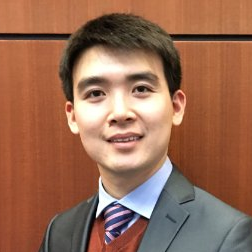The recipient of the 2018 Nevada Medal for Distinguished Graduate Student Paper in Bridge Engineering is Ruoyang Wu, a doctoral student at the University of Utah.

Ruoyang Wu, doctoral candidate at the University of Utah and 2018 Nevada Medal winner.
The Nevada Medal is an annual award given to a graduate student paper that has made significant contributions to the state-of-the-art in bridge engineering.
The title of the winning paper is "Experimental and Analytical Study of Seismically Repaired RC Bridge Column-to-Cap Beam Connections." The paper presented a technique to repair severely damaged reinforced concrete bridge columns. Concentrated and distributed plasticity models simulating the repaired concrete columns were proposed to model damaged longitudinal steel bars, bond-slip effects, and low-cycle fatigue of the bars. Wu's research that led to the award winning paper was directed by Dr. Chris Pantelides.
The winning paper was selected by a group of experts in bridge engineering research and design. The award includes a plaque, an engraved 14-K gold-plated pin and a $1,500 check. The funding for the award was initially provided through an endowment established by Simon Wong Engineering of San Diego, California. Wong completed a bachlor's degree ('79) and an master's ('84) degree in civil engineering at the University of Nevada, Reno. The award is currently sponsored by the Civil and Environmental Engineering Department and coordinated by Saiid Saiidi, professor of civil and environmental engineering.
"It is my great honor to be selected as the recipient of the prestigious 2018 Nevada Medal for Distinguished Graduate Student Paper in Bridge Engineering," Wu said. "I would like to appreciate all the efforts and help from the advisory board and the sponsor of the award. Thank you for awarding me such a valuable honor."
Wu intends to continue his work on bridge column report as a bridge engineer or a researcher after graduation.
Experimental and Analytical Study of Seismically Repaired RC Bridge Column-to-Cap Beam Connections
Ruoyang Wu, Chris Pantelides
Abstract
A repair technique for two severely damaged reinforced concrete (RC) bridge columns has been was presented that utilizes a carbon fiber-reinforced polymer (CFRP) shell, epoxy anchored headed steel bars, and non-shrink high strength repair concrete to relocate the column plastic hinge. In one specimen, a steel collar with shear studs was installed to improve bond of the column concrete to the repair concrete, since the column was completely severed from the cap beam. Two analytical models, Model Fiber and Model Rotational Spring (RS), simulating the seismic performance of the repaired specimens are proposed in this paper. In Model Fiber, distributed plasticity considering bond slip is assumed to be concentrated in a plastic hinge length of the nonlinear beam-column element. In Model RS, concentrated plasticity was considered using a non-linear moment rotational spring located at the repaired cross-section. A sectional moment-curvature analysis was performed considering the damaged steel properties and bond-slip effects to obtain the moment-rotation relationship, which is assigned to the nonlinear rotational spring. Numerical simulations show that the results are in good agreement with the experiments in terms of hysteretic response, cumulative hysteretic energy, and moment-rotation capacity. Model Fiber can also predict the local response and the low-cycle fatigue of the longitudinal steel bars. Using appropriate pinching parameters, Model RS can obtain accurate pinching behavior for both repaired CIP and precast concrete specimens.












